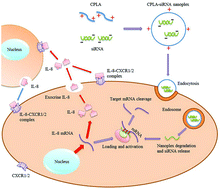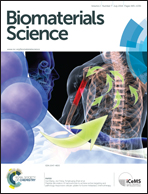Interleukin-8 gene silencing on pancreatic cancer cells using biodegradable polymer nanoplexes
Abstract
Pancreatic cancer is one of the deadliest cancers throughout the world with rarely efficient therapies currently available. Gene therapy on pancreatic cancer through small interfering RNA (siRNA)-based RNA interference (RNAi) has shown great potential and attracted much attention. However, due to the fragile nature of nucleic acid, the application of RNAi as a safe and efficient carrier faces great challenges. In this contribution, a self-assembly regime, which is based on well-defined cationic polylactides (CPLAs) with tertiary amine groups, has been used to encapsulate and protect siRNAs from fast degradation. CPLA is a safe and degradable formulation that allowed us to deliver siRNAs targeting the proangiogenic chemokine interleukin-8 (IL-8) to pancreatic cancer cells for gene therapy. Stable IL-8 siRNA–CPLA nanoplexes were successfully formed by electrostatic force and high gene transfection efficiencies were shown on two pancreatic cancer cell lines. We did not observe any cytotoxicity from these CPLAs over a large concentration range via cell viability evaluations. More importantly, the silencing of IL-8 gene expression significantly attenuated the proliferation of pancreatic cancer cells. Our preliminary results support the future development of gene therapy that might provide an effective and safe treatment approach towards pancreatic cancer.


 Please wait while we load your content...
Please wait while we load your content...